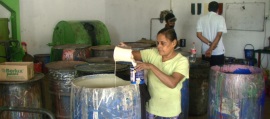
by Brianna Crandall — April 24, 2015—Since the U.S. federal government banned consumer uses of lead-containing paint in 1978, and lead exposure in the United States tends to come primarily from renovation and preservation projects, many readers may be surprised that over half of the countries in the world still allow lead in household paint.
The Global Alliance to Eliminate Lead Paint, co-led by the United Nations Environment Programme (UNEP) and the World Health Organization (WHO), announced the goal of eliminating lead paint around the world by 2020 at the Global Citizen 2015 Earth Day this past week. UNEP’s Goodwill Ambassador Don Cheadle announced the goal to a large crowd in Washington, DC, to celebrate the 45th anniversary of the first Earth Day.
According to the Alliance, paint that contains high levels of lead additives poses a great risk of lead poisoning, especially for children and pregnant women. When lead paint is used in homes, schools and playgrounds, young people are directly and constantly exposed to high levels of lead from paint chips and in dust or soil. Lead poisoning can have lifelong health impacts on children, including reduced IQs, learning disabilities, hypertension and seizures, and some 143, 000 deaths per year in developing countries.
While substitutes for lead paint are cost effective and easily accessible, the use of lead for decorating homes, schools and children’s toys is still permitted in numerous countries. More than 90 years after the League of Nations called for a ban on lead in paint, the Global Alliance to Eliminate Lead Paint is still working to phase out the manufacture and sale of paints containing lead to eliminate the risks that such paints pose.
In its work towards reaching the goal of eliminating lead from paint by 2020, the Alliance can reportedly draw on the success of phasing out lead in fuels. Global action to this end, catalyzed by the Partnership for Clean Fuels and Vehicles, has reached a point where only three countries in the world still use leaded gasoline.




